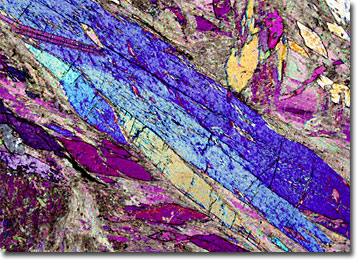Polarized Light Microscopy Digital Image Gallery
Talc-Tremolite Schist
Schist is a crystalline rock with a finely foliated structure that enables it be easily cleaved into layers. Most schists are primarily comprised of platy minerals, such as micas, that occur in sizes large enough that they are visible to the unaided eye.

Talc is a mineral that is most commonly known in the form of soft white talcum powder. However, the substance, which is usually described as exhibiting a greasy, soapy feel, may occur in a range of colors that extends from gray to red to brown, depending on the impurities present. The hydrous silicate of magnesium, which sometimes occurs as an alternation product of tremolite, may also be found in a variety of forms, including finely or coarsely granular masses, as well as the thin layers known as folia in which it most commonly occurs. Compact aggregates of talc are often known as soapstone, a material that has been a popular choice for carvings and ornamental items since antiquity.
Fairly common in metamorphic rocks, tremolite is a white or pale green member of the amphibole group of rock-forming minerals. The name of the substance derives from Tremola, a valley in the Alps where it was initially discovered and described. Though typically found as short prismatic crystals or in long blades, one variety of tremolite commonly called mountain leather occurs in aggregates that look and feel similar to cloth. This occurrence is due, in part, to the fact that tremolite is sometimes composed of the microscopically fibrous crystals known as asbestos.
